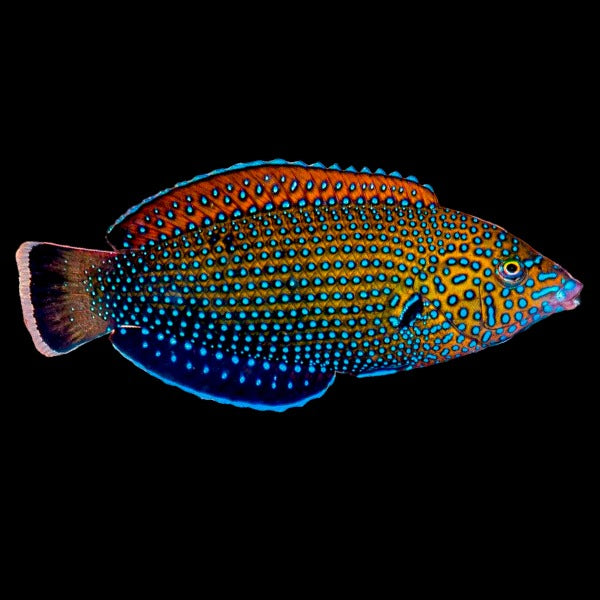Description
Click HERE to read our Dead On Arrival (DOA) policy.
Click HERE for how to acclimate the fish.
The Blue-Spotted Wrasse, scientifically known as Anampses caeruleopunctatus, is a small, strikingly colored marine fish that belongs to the family Labridae. This species is native to the Indo-Pacific region and is recognized for its vibrant and distinctive blue markings.
Here are some key characteristics and information about the Blue-Spotted Wrasse:
Appearance: Blue-Spotted Wrasses are known for their vivid coloration. They have a predominantly orange-red body with bright blue spots covering their head and body. They also have blue markings on their fins. These blue spots give them their common name.
Size: These wrasses are relatively small and typically reach lengths of around 3 to 4 inches (7.5 to 10 centimeters).
Habitat: Blue-Spotted Wrasses are commonly found in coral-rich environments, including reef slopes and lagoons. They prefer warm, tropical marine waters with ample hiding places among coral formations.
Behavior: They are active and inquisitive swimmers, often darting in and out of coral formations while searching for small invertebrates and crustaceans to feed on.
Diet: In the wild, their diet primarily consists of small invertebrates, including crustaceans, worms, and zooplankton. In captivity, they can be fed a diet of high-quality marine flakes, frozen foods, and live foods to ensure their well-being.
Aquarium Keeping: Blue-Spotted Wrasses are sometimes kept in marine aquariums, particularly in reef tanks, due to their striking appearance and active behavior. They require a well-maintained tank with live rock for them to explore and graze on, as well as plenty of hiding places. They are generally peaceful and can be kept with a variety of other fish and invertebrates.
Like other marine fish, Blue-Spotted Wrasses require a suitable environment and stable water quality to thrive in captivity. Providing a balanced diet and proper care is essential to ensure their health and well-being in an aquarium setting.
- Care level: Moderate
- Temperament: Peaceful
- Diet: Carnivore
- Reef Compatible: Yes
- Family: Labridae
-
Minimum Tank Size: 90 gallons
- Size: Medium 2"- 3"

